 I walked home and sat on the stoop and watched the sun sink behind the trees and held the cat. It was a fine cat. 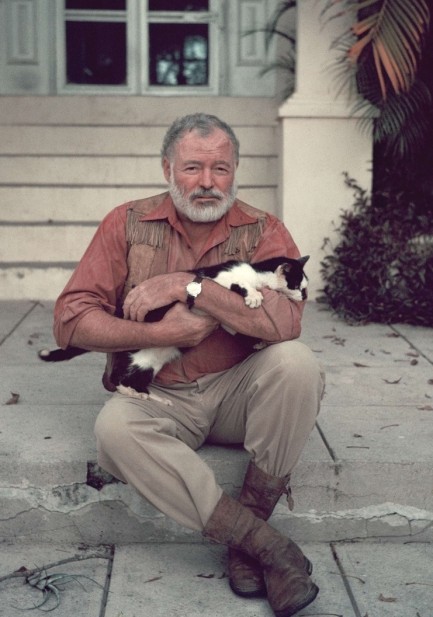
Above is one of the better photos of one of the better writers, Ernest Hemingway, seen here in 1954 at his house Finca de Vigía, which was located in San Francisco de Paula, Cuba. He owned the house and fifteen acre grounds from 1939 to 1960, and it was there that he wrote part of For Whom the Bell Tolls and all of his Pulitzer Prize-winning The Old Man and the Sea. The cat mostly walked across his typewriter keyboard.
 Honey! Oh no! There goes your undefeated record! And in your very first fight! 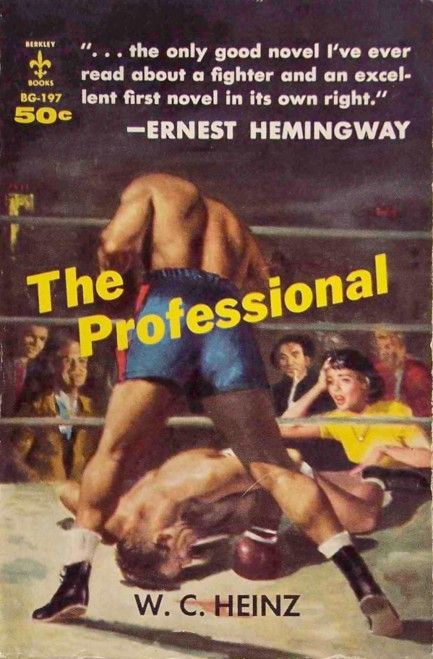
This 1959 Berkley Books edition of the 1958 W.C. Heinz boxing novel The Professional has excellent Robert Maguire cover art of a boxer on the deck and a distressed woman looking on in horror. You'll also notice Ernest Hemingway's endorsement. Papa's fame led to his stamp of approval being highly coveted. We'd guess we've seen his name used this way on ten covers, but we bet there are more. If you go by the reviews on this book, Heinz deserved all the praise he received for his tale of a middle-weight boxer trying to climb to the top. As an award winning sports writer he knew his stuff, and he collected other accolades to go with his anointment by Hemingway, winning the E. P. Dutton Award for best magazine story of the year five times, and earning the A. J. Liebling Award for boxing writing. Over the decades Heinz had his work reprinted in dozens of anthologies and textbooks, so if you're into sports journalism he's one of the main dudes. We have a fair number of boxing covers in our website, and they tend to be amusing if you look at them just the right way. We won't link to them all, but if you want to see some good examples try here, here, here, here, here, and here.
 Some things are too ugly to be prettied up. 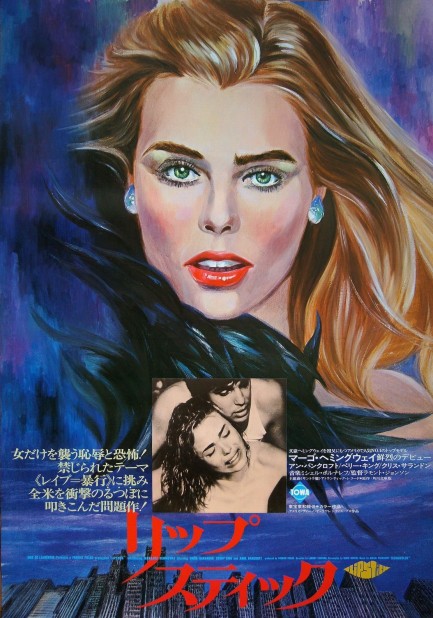
A thriller with two of Ernest Hemingway's granddaughters as stars? We had to check it out, especially when we found this beautiful Japanese promo poster. The movie was titled Lipstick, and the Japanese title リップスティック is identical. Margeaux Hemingway plays a New York City model, and her little sister Mariel Hemingway plays her daughter. They become obsessions for a pig of a sexual predator who insinuates his way into their lives, and things don't go well. At all.
Using rape as the central element of thrillers is not very 2022, even as the actual issue exists in perpetuity. Any film that aims for a realistic depiction, no matter how well meaning, opens itself to charges of exploitation. There's no doubt the filmmakers wanted to wrap an issue inside a thriller, which means despite the beautiful cinematography and a setting in the glitzy, glimmery realm of high fashion, there's a disturbing aura of reality that makes the movie tough to watch in places.
However, this is a serious production and deserves a fair assessment. It's adequately-but-not-amazingly acted by Margeaux, co-star Anne Bancroft is solid, Mariel—who was only fifteen at the time but is playing a character of thirteen, and looks it—does serviceable work, and Chris Sarandon is believable as their assailant. Lipstick falls into the category could-not-be-made-today™, but overall it's worth a watch—and a post-credits discussion. It premiered in the U.S. in April 1976, and in Japan today the same year.
 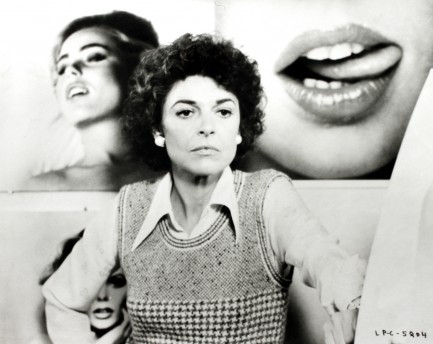 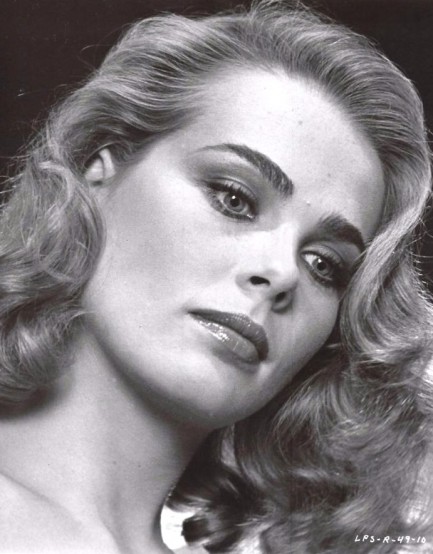 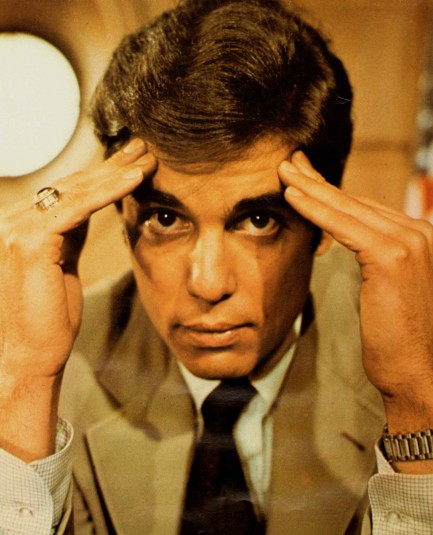  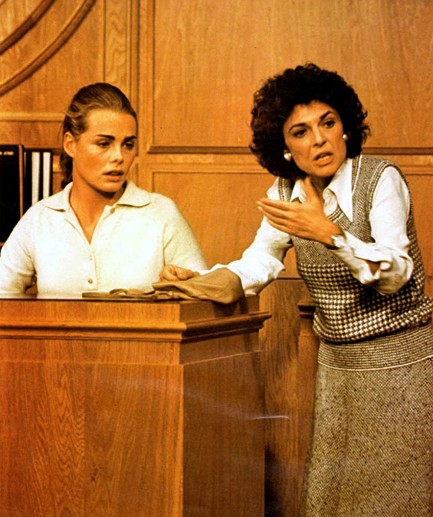 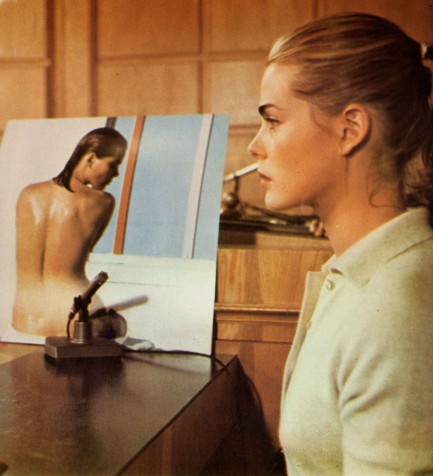 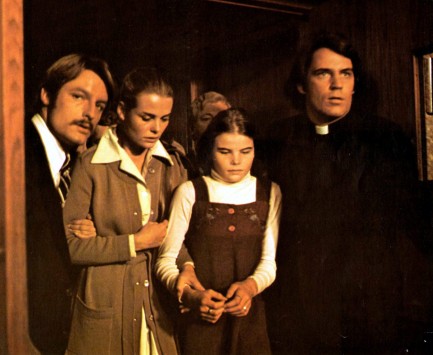 
 In The Killers she's absolutely to die for. 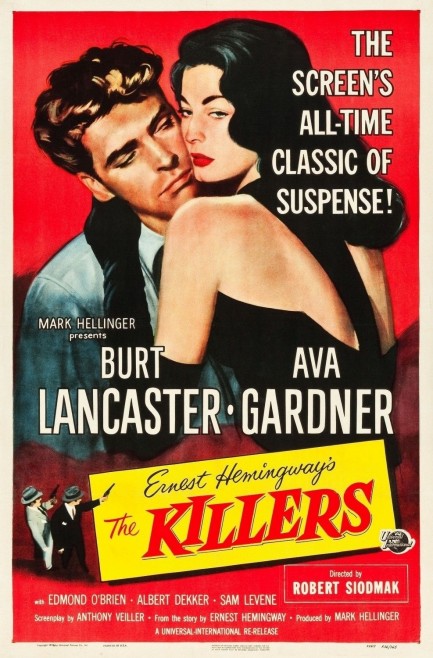
We've shared Swedish, French, Australian, and U.S. promo art for The Killers over the years. But there was more than one U.S. poster, and you see an alternate version above, a nice crimson effort that has no artist credit. You already know the plot of this film, so we won't rehash it, but we wanted to single out something we love about film noir—the spectacular entrance of the femme fatale. Remember Rita Hayworth's first screen moment in Gilda? “Gilda, are you decent?” “Me?” That might be tops. Lana Turner in The Postman Always Rings Twice, those white shorts and that weird headwrap. Lauren Bacall in To Have and Have Not. “Got a light?” There are many others, and men sometimes get good entrances too, but Ava Gardner's first moment in The Killers, sitting at a piano in a swank Manhattan apartment, with that light—you know the light we mean—glowing on her face, is another great example. Then she gets a song. You gotta love it. 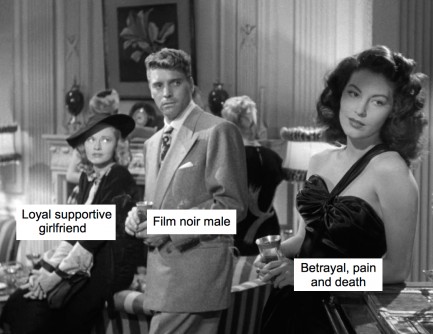
 When I'm a really big star there'll be a photo retoucher to make sure I have perfect armpits. 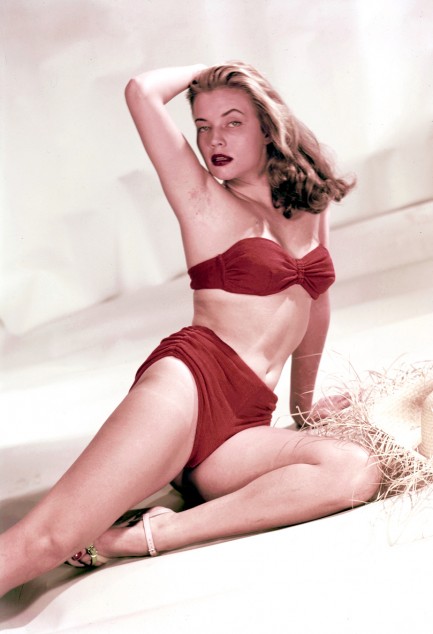
This scan made from a 35-millimeter slide shows Hungary born actress Ava Norring, who had exactly one credited role—that of Beatrice in 1952's The Snows of Kilimajaro, in which she appeared with her more famous namesake Ava Gardner. She later was featured in an eight page Esquire photo essay published in July 1955, but stardom was not to be. We love this shot, underarm razor burn and all. We haven't seen The Snows of Kilimajaro, but we're curious about it. The 1936 Ernest Hemingway work upon which it's loosely based is a short story (touching on standard Hemingway themes we discussed a while back), and it's always interesting to see how filmmakers flesh out something so slight. We'll get to the movie at some point, see both Avas in action, and probably report back.
 Hemingway scales the literary heights by plumbing human depths. 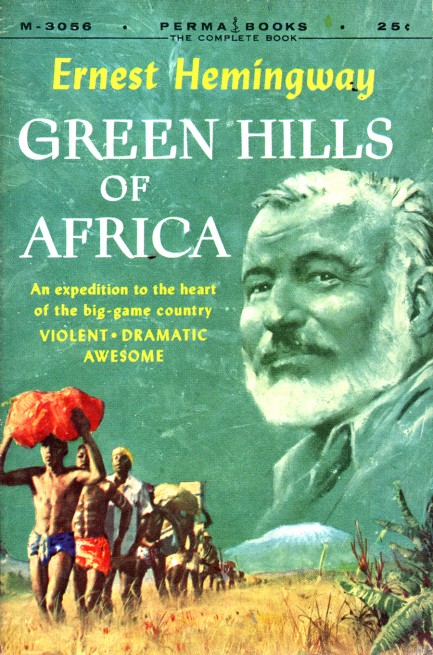
The great film director John Huston once made an interesting observation about Ernest Hemingway. He said Hemingway had fallen out of fashion because he wrote about courage. Huston didn't mean courage like Liam Neeson facing a pack of wolves or a terrorist. He meant the willingness to face temporality and mortality, and accept them for what they are. He meant the willingness to try to achieve things of great personal value while realizing none of them would last, and none of them truly mattered. The cultural trend has always been to tell people they're special and what they think and do matters and will last. But Hemingway considers that a conceit. 99.99999% of people are simply forgotten. The things they did are forgotten too.
This has happened to the most famous people of their eras. Name a U.S. governor who was in office during the Civil War. Name the wealthiest landowner of imperial Rome. They probably never imagined they'd be forgotten. Human temporality and mortality, set against the backdrop of nature or conflict, is Hemingway's thing. Nihilistic themes date from the earliest literature, but Hemingway, in projecting these ideas through a modern, almost pop culture lens, spoke for generations who had experienced two of the largest and deadliest wars in human history—we're talking well over 100 million dead. Hemingway was wounded in Italy in 1918. George Orwell was shot through the throat in Spain in 1937 during a precursor conflict to World War II. Erich Maria Remarque sustained multiple wounds in World War I. Imagine literature without them.
100 million war dead, among them writers who never wrote, painters who never painted, inventors who never invented. The world lost untold human capital, immeasurable progress. The literary public was ready for authors to tackle the senselessness of warfare. The between-wars period, encompassing a flu pandemic that killed 50 million, followed by the Great Depression, was likewise a wellspring of disillusionment. All these upheavals made clear that everything hangs by the barest thread. That level of suffering is unknown in the U.S. today, a country that has had its constant warfare sanitized for easy consumption, and that's really why Hemingway is out of favor—because his themes are almost alien to an American public that has forgotten what it means to suffer on a mass scale.
But while it's been fashionable for the last forty or so years to bash Hemingway, it's a self defeating exercise. We think what people usually mean to bash is his stature, or his out-of-date attitudes, which are understandable criticisms. However, to say he's a bad writer is to make oneself look ridiculous. We've said a few times before, and we'll say again here, that a good writer teaches you how to read their work. It's similar to the idea of willing suspension of disbelief in cinema. You accept the premise, or don't bother watching the film in the first place. It's okay to dislike a book as long as you try to read it on the terms the author asks. Otherwise, why bother? You read an adventure author on his or her terms, a mystery author on their terms, and a sleaze author on their terms. And certainly, you read a literary author on their terms.
None of this is to say Hemingway didn't have flaws, particularly when viewed trough a modern social lens. At Pulp, we tend to view writers as content producers first. For example, we pointed out recently that Camilo José Cela was a fascist. We personally are the opposite. But Cela still could write. Seeking enrichment only from ethically pure artists makes for a meager diet, and ethical purists should be forewarned—though modern judgments are necessary tools for measuring our progress, judgments come down the pike for everyone eventually. Legions of twenty-somethings who think they're pristine will one day be blamed for enabling slavery because they used smartphones dependent upon forced labor in African cobalt mines. Ethics evolve, and generational judgment comes for all.
Green Hills of Africa, originally published in 1935, with the Perma Books edition you see above coming in 1956 with Robert Schulz cover art, is autobiographical. A thirty-six year old Hemingway goes on safari mainly in Tanzania, and sets his personal goals against vast and indifferent wilds. By design nothing important seems to happen, but through his descriptive powers he brings Africa to the fore, and makes himself a bit player, just an ant on the endless landscape. The narrative could be shorter and more focused, but even as it rambles the same way Hemingway rambles across the dry plains, his wide ranging hunt for kudu, rhino, and lion assumes an almighty personal importance. His desire draws you in. His many small triumphs and failures become increasingly gripping, and sharpen the irony of his own impermanence and the impermanence of his acts.
But as we've mentioned before, Hemingway and his ilk operated under an earlier—and mistaken—ecological understanding. Our acts actually do matter, not because we're individually important, but in the accumulation of our billions of tiny effects. Hemingway assumed humans had no meaningful impact on nature. Now we know that's only half true—we're impossibly insignificant and incredibly impactful. We're tiny animalcules that have heedlessly wrecked a vast ecosystem. Green Hills of Africa is like a work of high fantasy, taking place in a reality that never truly existed. Despite its mistaken assumption, it does exactly what Hemingway wanted—says that nature is implacable, while human acts, achievements, and loves are comically impermanent. That was his message, a message people were ready to hear. That was Hemingway.
 No one's gonna save you from the beast about to strike. 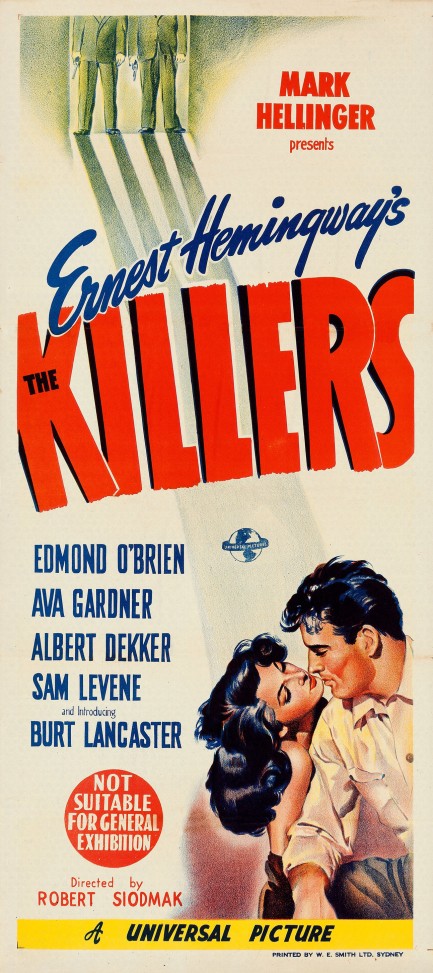
Burt Lancaster as a doomed boxer named Ole Anderson, shot dead one night by a couple of hit men, is a seminal character in film noir. He epitomizes the major characteristic of the genre, that of a person caught in dangerous circumstances beyond their control. He's so caught he never tries to run or defend himself. He lets the killers shoot him. We didn't spoil anything by telling you that—Anderson is dead ten minutes after the movie opens. Using Ernest Hemingway's short story of the same name as a starting place, The Killers takes a typical endpoint for a film noir and flips the timeline around so that the drama becomes finding out why Anderson suffered such a hopeless demise. Sunset Boulevard would pull the same trick later in visionary fashion by having the dead character actually narrate the movie. We've shown you several posters for The Killers, but this one made for the Australian market is, well, killer. Compare it to the U.S. promo here. The movie premiered in Australia today in 1947.
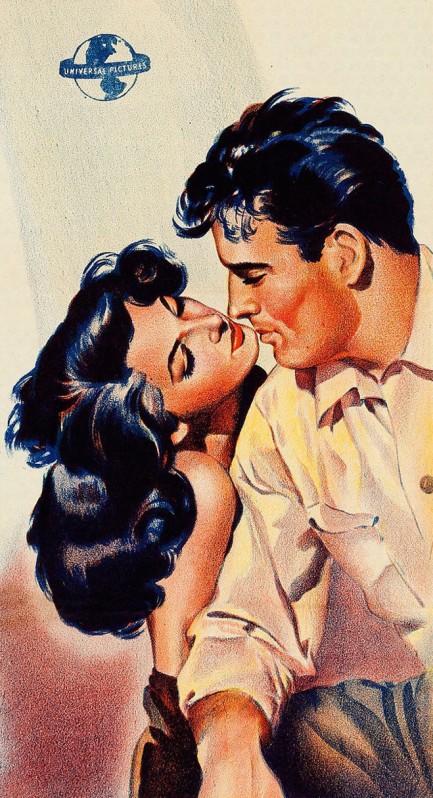
 Some guys just can't catch a break. 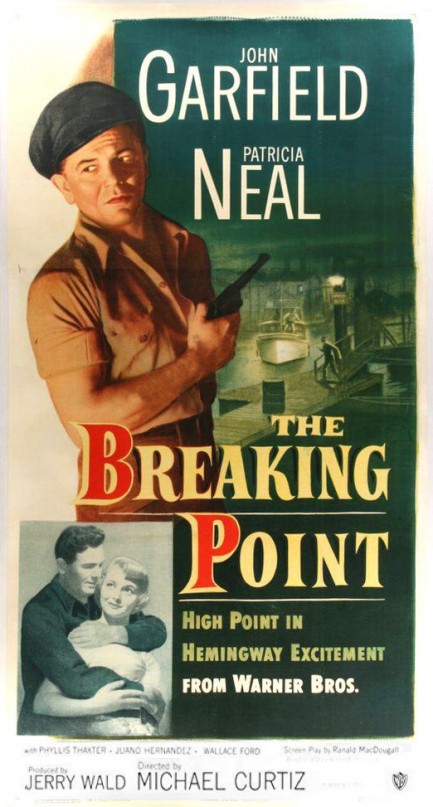
The Breaking Point is the second of three Hollywood adaptations of Ernest Hemingway's novel To Have and Have Not, and it's a very good one. You're already starting from an advantageous point when you have John Garfield in the starring role. He could act, and this part requires quite a bit from him. This was his next-to-last movie—he would be dead two years later, victim of a congenital heart problem, exacerbated by high stress, reportedly from his blacklisting that was the result efforts by commie hunters.
Casablanca director Michael Curtiz is on board here too, and he does a masterful job bringing the story to life. Curtiz, or Warner Brothers, or both, decided to transplant the novel's action from Cuba to Newport Beach, but the theme of a man caught in untenable economic circumstances remains. Those who wanted a reasonably faithful adaptation of Hemingway's story got it in this film. The first version, also called To Have and Have Not, was amazing but had little in common with the source material. The third adaptation, The Gun Runners, was also good but downplayed certain political themes. (There's also an Iranian version we haven't seen and which we'll leave aside for now.)
So, which of the three U.S. versions is best? Is it really a competition? They're all compulsively watchable, but this effort with Garfield is the grittiest by far, and the most affecting. It's strange—To Have and Have Not is supposed to be Hemingway's worst book, but with three good movies made from it, maybe it isn't that bad after all. Perhaps because it's a work from one of the most influential authors ever to write in English, the bar was just set too high. Maybe it really is Hemingway at his worst, but personally we think it's very good. The Breaking Point premiered in the U.S. today in 1950. 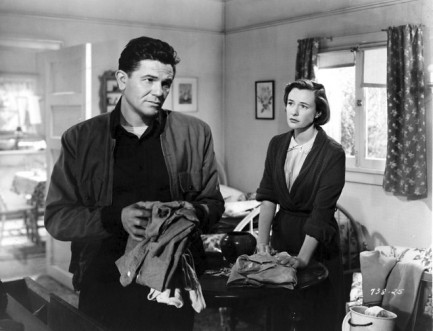 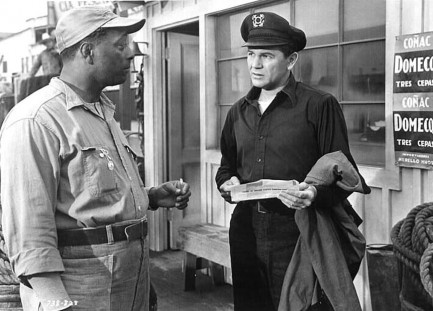 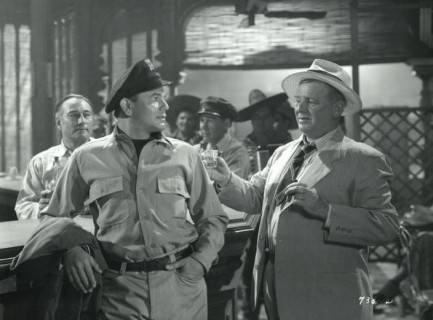 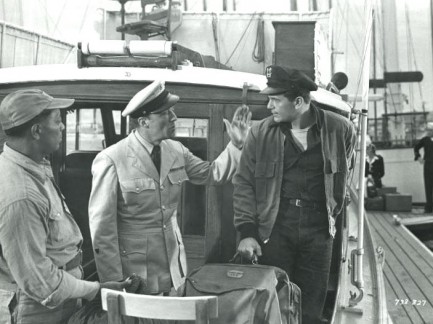 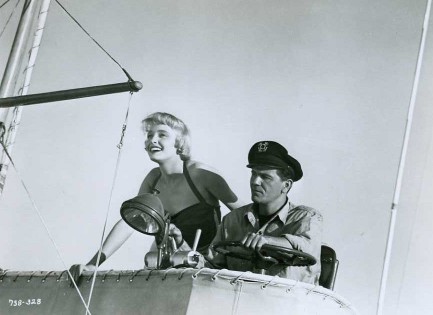 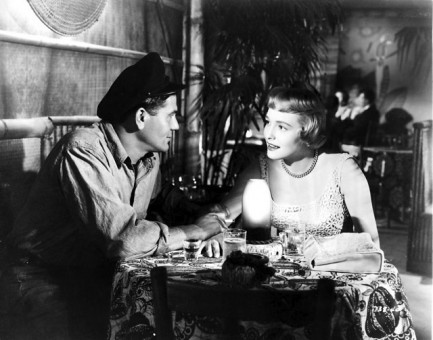 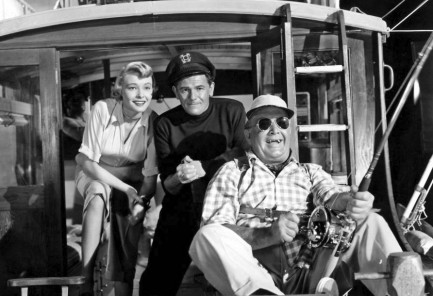 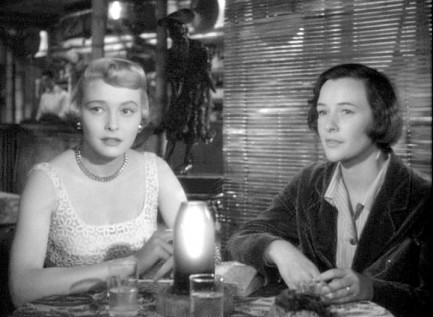 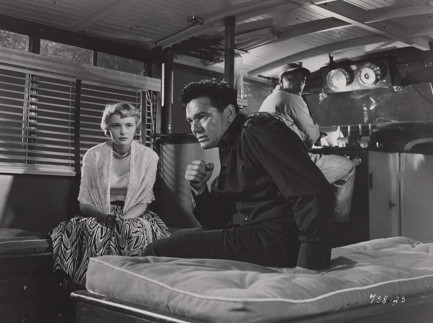 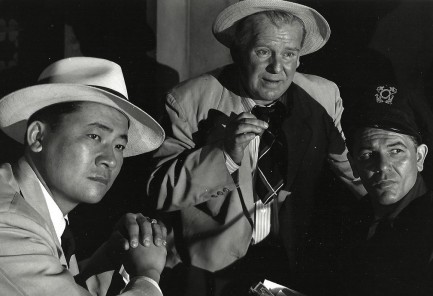 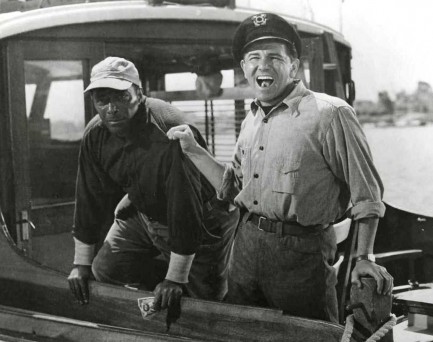 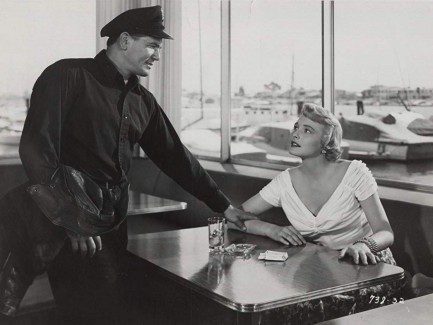 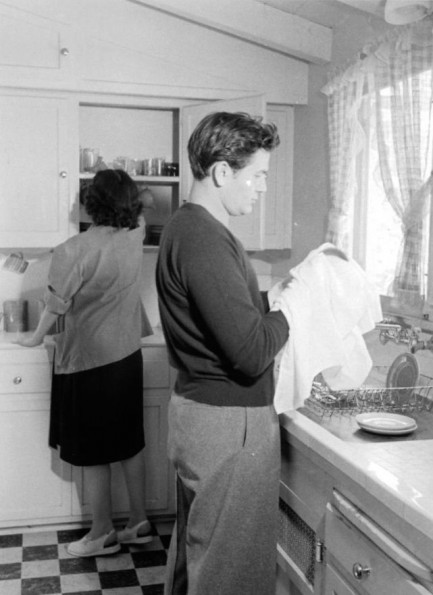 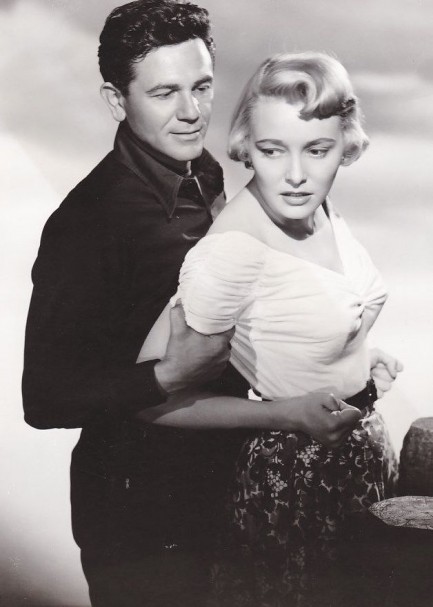
 Hemingway's lament for the downtrodden working class is supposed to be his worst novel. But is it really? 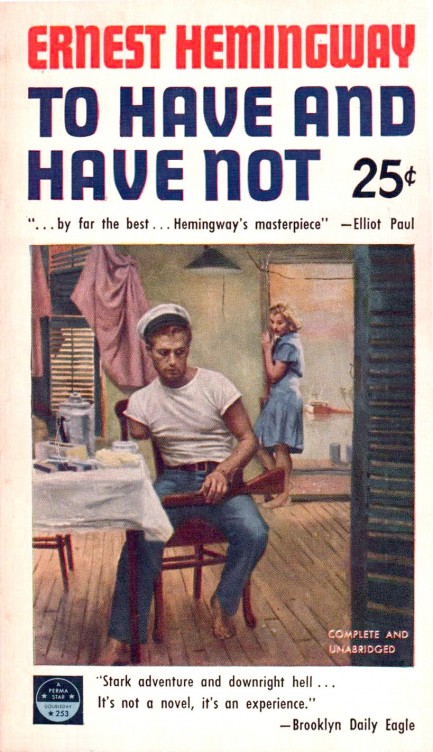
Don't let the cover blurbs fool you. In general To Have and Have Not is considered by critics to be Ernest Hemingway's worst novel. Originally published in 1937, it was completely rewritten and became a great 1944 movie with Humphrey Bogart and Lauren Bacall. If you've already seen the movie but never read the book, hold onto your hats, because this is extraordinarily rough stuff from Hemingway, a tale of desperation and murder in the depths of the Great Depression. Harry Morgan is a Key West boat captain who's stiffed for $825 after his three-week charter skips town. That would be about $15,000 in today's money, so it's no surprise that losing this bundle means Morgan, who's married, has three kids, the usual assortment of bills and responsibilities, and has spent his life fighting to get ahead, is now destitute.
If you opt to read the book, make sure not to gloss over exactly how far in the hole Morgan is. $825 dollars would bend the morals of most people in 1937, just as $15,000 would today. After being cheated out of this cash he makes a fateful decision to turn criminal himself by running illegals from Cuba to Florida. That's when things go from bad to worse. If you look closely at the cover art on this Perma Books edition from 1953 you'll see what the result of Morgan's criminal foray was. That's one reason cover art is so interesting. The scene the artist chooses to depict—in this case it's Tom Dunn—can sometimes be so specific as to give away an important plot point. If you can't tell what we're talking about by looking at the art we'll give you a hint. What happens to Morgan is the also title of an earlier Hemingway book.
But moving on, To Have and Have Not is—we'll just come out and say it—brutally racist. There are some who would like to gaslight you into thinking you're seeing something that isn't there, and others who would prefer you to ignore this, but you shouldn't, because racism is actually pivotal in the narrative. Morgan's initial foray into crime is against people he clearly feels are subhuman. They and other ethnic groups are referred to with slurs, and these come not just from Morgan's mouth, and from his thoughts, but from the writer's thoughts too. There are places where Morgan uses actual names to refer to characters that Hemingway still refers to by slurs. Think: “Hey Joe, give me a hand with these poles,” said Harry. The [slur] put down his coffee and helped Harry with the poles. So while it's always good to separate the author from their fiction so they have freedom to create any sort of characters they wish, it still raises an eyebrow when you read something like that.
Another aspect of To Have and Have Not that may jar is its lack of sympathetic characters. Morgan's ex-prostitute wife Marie is probably the nicest person in the book, and even she drops n-bombs all over place. But you have to root for someone, so it's her and Harry. You do it because they're at the economic mercy of terrible people. Most of these folks—who are generally of a better class—wouldn't use racial slurs, but they also wouldn't think twice about ruining someone for a few dollars. And while Harry employs a black man and gets along with him fine, you can be sure none of his rich charters would let a black man deign to speak to them. So in its way, To Have and Have Not is relevant in 2020 by starring a working class character who's uncouth, uneducated, and devoid of genuine empathy, but who constantly deals with people that think they're better than him and really aren't.
This is why losing the charter and those $825 bucks is such a clever way to open the novel. The charter, Johnson, flies away and doubtless never gives what he did much thought, but in shafting a working man creates wreckage that crushes not just the man he cheated, but those around him. We think this is the way to focus on the book if you read it—acknowledge the obvious deficiencies of Harry Morgan, but pay close attention to the secondary characters. This is what Hemingway wanted, which is why Morgan's narration lasts for only a while. Everything after his first crime caper is told from outside his point of view. As the book goes on, Hemingway drags you deeper into the lives of these ancillary characters, dispassionately leaving a struggling Morgan to recede into the distance.
So is To Have and Have Not Hemingway's worst book? We don't like it as much as his other works, but with its changes in point-of-view, mood, and even narrative tense, it's also more challenging than those books. Ultimately, the most serious indictment of To Have and Have Not comes from the author himself—he thought it was his worst book too. And who are we argue with Ernest Hemingway? But on the other hand, when you write The Sun Also Rises and For Whom the Bell Tolls, and win a Pulitzer Prize for The Old Man and the Sea, and later win a Nobel Prize for your body of work, your worst book can still be pretty good.
 Whether by day or night the action was non-stop. 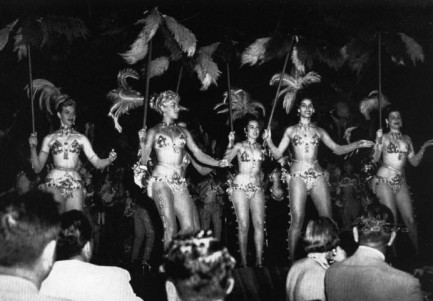
We love vintage nightclub photos, and vintage pix of people partying in general. Since Havana photos are unusually interesting, we're always drawn to them. There's a large number of Havana photos out there, but not primarily because of Cuba's political history. The photos really exist because Cuba was a pioneer of Caribbean tourism, attracting travelers beginning in the 1920s through a heyday of the mid-1950s. The island was promoted as a place of sophistication, mixed with permissiveness, unpredictability, and a touch of the primitive. This prompted various movers and shakers—from New York City businessmen to top musicians to Hollywood stars—to flock to Havana. And where important people went, cameras followed.
Was the Havana image true? Probably, based on what we've read. But it was not unique. During the same period Tangier had a similar reputation, as it attracted writers like Paul Bowles, William S. Burroughs, and numerous gay expatriates. During the 1960s Acapulco was known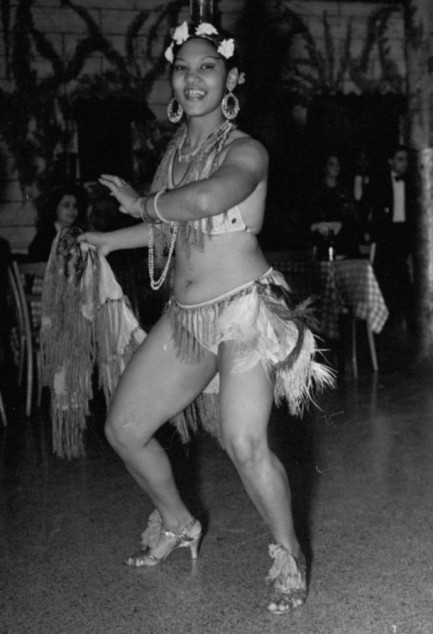 as a great place to go for thrills. During the 1980s, Ibiza or Mykonos. The 90s, Thailand or Goa. The 00s, Tulum. Havana wasn't unusual in terms of what it offered. Bigger, yes. More convenient for Americans, for sure. But numerous far flung locales have served as paradises for foreign visitors to lose themselves and get crazy. as a great place to go for thrills. During the 1980s, Ibiza or Mykonos. The 90s, Thailand or Goa. The 00s, Tulum. Havana wasn't unusual in terms of what it offered. Bigger, yes. More convenient for Americans, for sure. But numerous far flung locales have served as paradises for foreign visitors to lose themselves and get crazy.
Most or all of the aforementioned places are considered to have changed for the worse, whether through ecological damage, destruction of historic architecture, unchecked overbuilding, overtourism, or all four scourges at once. But it was revolution that changed Havana, a fact that gives vintage photos from there a particular poignancy. A typical narrative is that while elites and tourists partied, exclusion, inequality, and poverty helped fertilize the seeds of upheaval. But we don't judge anyone in these shots. We've lived in similar circumstances in Central America. We were even partners in a beach bar in the Caribbean. We were always well aware of the prevailing socio-political problems, and we sympathized greatly with the local populations. But it didn't stop us from partying the nights away.
There's an immense feeling of freedom being in a simpler place—and for all its opulent nightclubs and restaurants, Havana is said to have exuded a primeval sensuality that intoxicated tourists and expatriates. If you live in the U.S. or some other modern nation, that feeling isn't something you can achieve by merely paring down your current lifestyle. The things you give up continue to exist all around you. By rejecting those, you become a weirdo. But by living in a less modern nation your life truly changes top to bottom, and you gain this while still existing above the local mean. That's the paradox, or the injustice, depending on your point of view: your satisfaction derives partly from the ability to take or leave anything you wish, because you are economically able to do so. You live more simply than you did, yet live better than most people around you. It isn't noble, but it's very much an attraction.
Bowles and Burroughs lived well in Tangier because it was immensely cheaper than Europe or the U.S. With the savings gained they hosted parties and had time to hone their literary crafts. They were a part of the local society, but existed in a middle-upper stratum, high above the impoverished, well below the Moroccan elites, benefitting from the general perception that foreigners from rich nations are themselves rich. That's how it was for us too. So there's inequality built into that type of expatriate experience. It's unavoidable. A friend of ours lived in a stick shack on Cayos Cochinos for an entire year and he was still considered a rich foreigner. Everyone knows you have a choice. The Americans who partied in Cuba could never have been anything but wealthy invaders, no matter the reality of their finances, or the inclusiveness their sensibilities. type of expatriate experience. It's unavoidable. A friend of ours lived in a stick shack on Cayos Cochinos for an entire year and he was still considered a rich foreigner. Everyone knows you have a choice. The Americans who partied in Cuba could never have been anything but wealthy invaders, no matter the reality of their finances, or the inclusiveness their sensibilities.
Living comfortably means the novelties one experiences seem thrilling or romantic. When we were knocking around Guatemala, El Salvador, and the Bay Islands, we turned washing our clothes by hand into an enjoyable ritual, yet understood quite well that many families' daily water intake literally depended on walking a mile to a river. Buying food from the local fruit and veggie stand was far more convenient than queuing at the supermarket for meat, and we ended up dropping to our college weight, but we were nevertheless aware that many people couldn't afford any food, and would have been disgusted at how pleased we were that our reduced fat intake meant we could show six pack abs at the beach. We helped some local families, both financially and logistically, but when your downsized existence is a choice you can never truly fit in.
But the freedom you feel is real. Offloading the burdens of modern life brings legitimate satisfaction. The pursuit of pleasure takes on a special joy. We hit bars, parties, and gallery mixers continually. As foreigners there's no social stigma to drinking every night. Unless you have a job—and we didn't—it's how you form a social circle. Locals generally disapprove, but their judgements carry little weight. So when we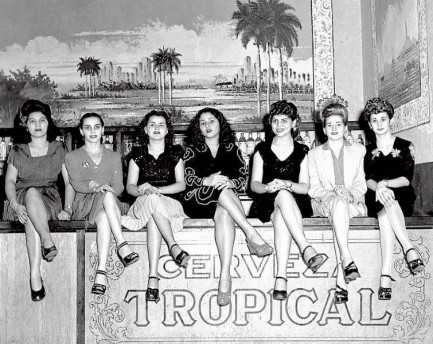 look at Havana partying shots we don't quite see oblivious, entitled people, because we know it isn't that simple. Most of them knew what was percolating. Stability was diminishing fast. There was a dissolved parliament, large protests, a 1953 battle in Santiago de Cuba, and other signposts on the way to change. It was clear the fun could never last. look at Havana partying shots we don't quite see oblivious, entitled people, because we know it isn't that simple. Most of them knew what was percolating. Stability was diminishing fast. There was a dissolved parliament, large protests, a 1953 battle in Santiago de Cuba, and other signposts on the way to change. It was clear the fun could never last.
The assortment of people you see here are caught on film like insects caught in amber, long dead but preserved. They're having a few laughs, enjoying some drinks, executing deft turns on dance floors, making their small, temporary marks on the world, leaving behind images showing them for one sliver of a moment in timeless eternity. Things changed in Havana, and now things have changed for all of us. If circumstances where we can dance and laugh and shout together in hot crowded places without fear of sickness ever return, be sure to embrace them fully. We don't just mean in some far flung tropical enclave. We mean anywhere. Because if it isn't a virus that takes those pleasures away, it'll be the march of years. You'll want to have done your best with this gift called life.
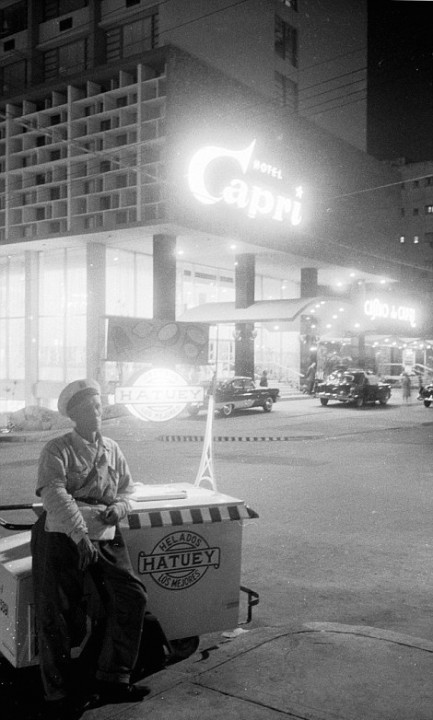 An ice cream vendor patiently waits for potential customers to emerge from the Capri Hotel and Casino, 1958. An ice cream vendor patiently waits for potential customers to emerge from the Capri Hotel and Casino, 1958.
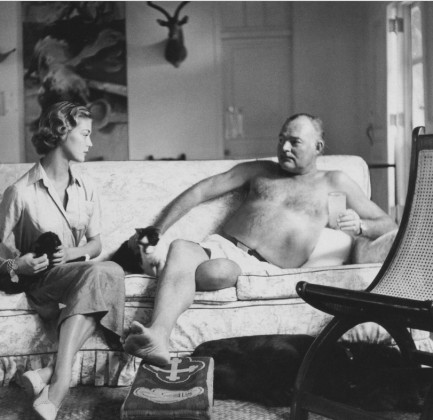 Fashion model Jean Patchett and author Ernest Hemingway, who habitually went shirtless, lounge at Finca Vigia, his house in Cuba, 1950. Fashion model Jean Patchett and author Ernest Hemingway, who habitually went shirtless, lounge at Finca Vigia, his house in Cuba, 1950.
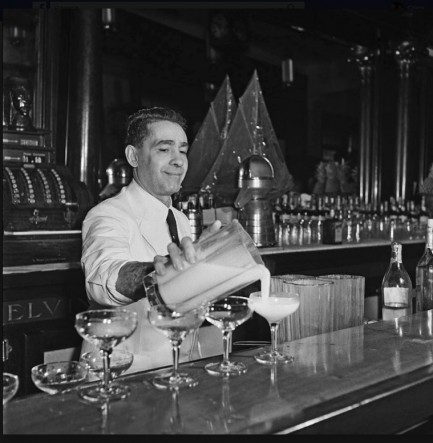 Above, Constantino Ribalaigua Vert, the "Cocktail King of Havana," inventor of the Papa Doble daiquiri, and owner of the famed bar La Floridita. Above, Constantino Ribalaigua Vert, the "Cocktail King of Havana," inventor of the Papa Doble daiquiri, and owner of the famed bar La Floridita.
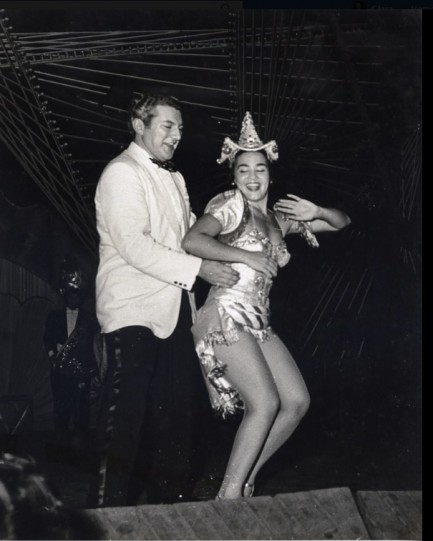 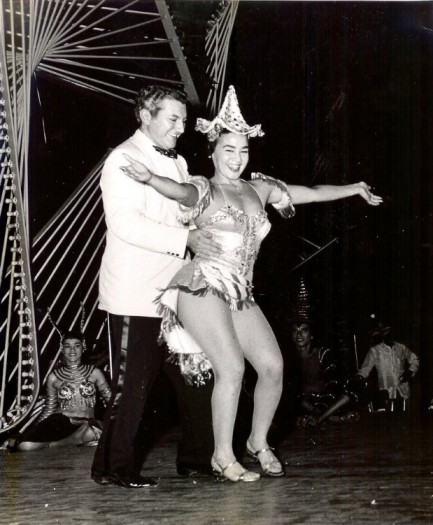 Liberace performs on stage at the Tropicana with headline dancer Ana Gloria Varona, 1954. Liberace performs on stage at the Tropicana with headline dancer Ana Gloria Varona, 1954.
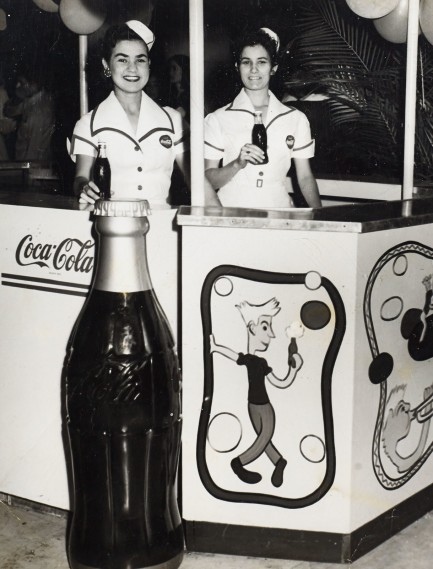 A Coke and a smile from two soft drink vendors. A Coke and a smile from two soft drink vendors.
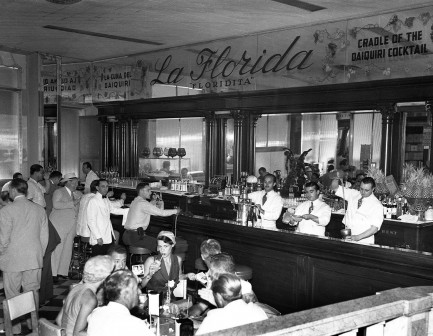 Patrons enjoy drinks at La Floridita, 1955. Patrons enjoy drinks at La Floridita, 1955.
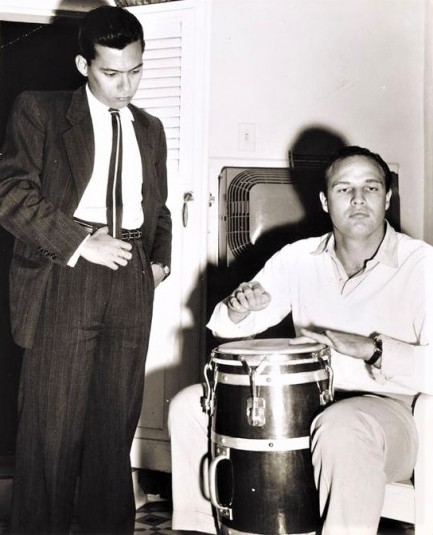 Cuban writer Guillermo Cabrera Infante stands by while Marlon Brando tries his hand—or both of them—at the conga drum at Hotel Packard, 1956. Cuban writer Guillermo Cabrera Infante stands by while Marlon Brando tries his hand—or both of them—at the conga drum at Hotel Packard, 1956.
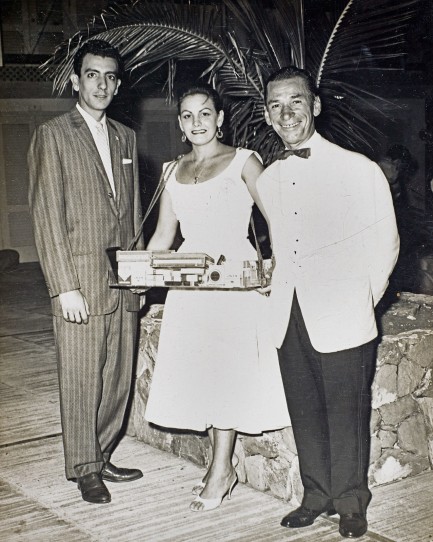 Mafia kingpin Meyer Lansky, on the right in this shot, attends the opening of the Hotel Riviera in December 1957. Mafia kingpin Meyer Lansky, on the right in this shot, attends the opening of the Hotel Riviera in December 1957.
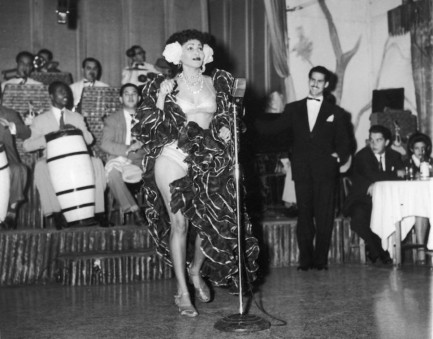 Famed entertainer Zulema dances the rhumba at the Zombie Club, 1946. Famed entertainer Zulema dances the rhumba at the Zombie Club, 1946.
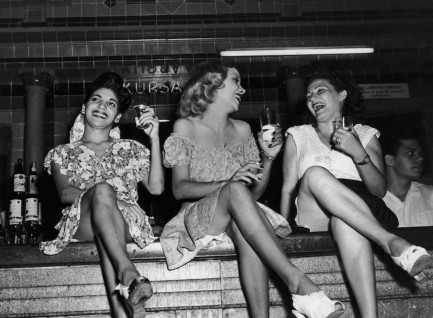 Three women liven up the room from their perch on the bar at Cabaret Kursal. Three women liven up the room from their perch on the bar at Cabaret Kursal.
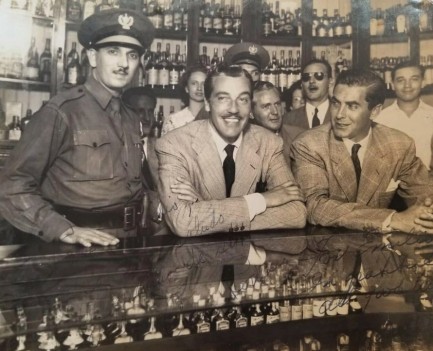 Cesar Romero and Tyrone Power enjoy a drink and a chat at Sloppy Joe's Bar. Cesar Romero and Tyrone Power enjoy a drink and a chat at Sloppy Joe's Bar.
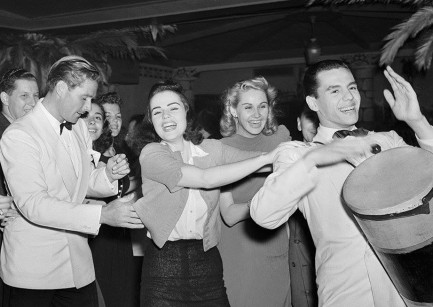 Revelers including Errol Flynn and Desi Arnaz, Jr. form a conga line during the Yoruba festival known as Dia de Babalú-Ayé. Revelers including Errol Flynn and Desi Arnaz, Jr. form a conga line during the Yoruba festival known as Dia de Babalú-Ayé.
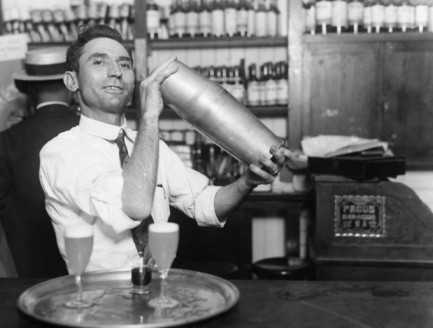 José Abeal Otero, founder of Sloppy Joe's Bar, mixes up a giant batch of liquid magic. No, this isn't the same person as above, Ribalaigua. They were both small, dapper guys. José Abeal Otero, founder of Sloppy Joe's Bar, mixes up a giant batch of liquid magic. No, this isn't the same person as above, Ribalaigua. They were both small, dapper guys.
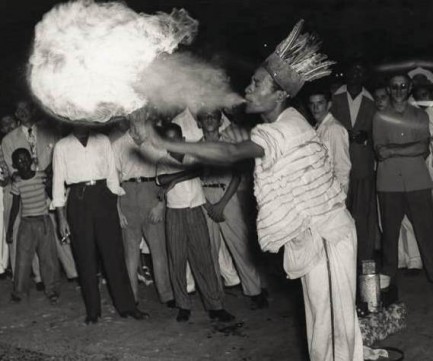 A firebreather thrills onlookers in front of the Saratoga Hotel, 1949. A firebreather thrills onlookers in front of the Saratoga Hotel, 1949.
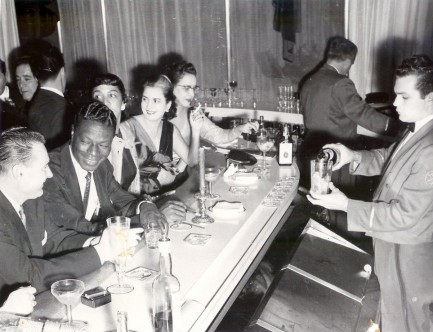 This photo shows Nat King Cole and his wife Maria Cole, along with Martin Fox, who was the owner of the Tropicana, accompanied by his wife Ofelia and an unknown fifth party. This photo shows Nat King Cole and his wife Maria Cole, along with Martin Fox, who was the owner of the Tropicana, accompanied by his wife Ofelia and an unknown fifth party.
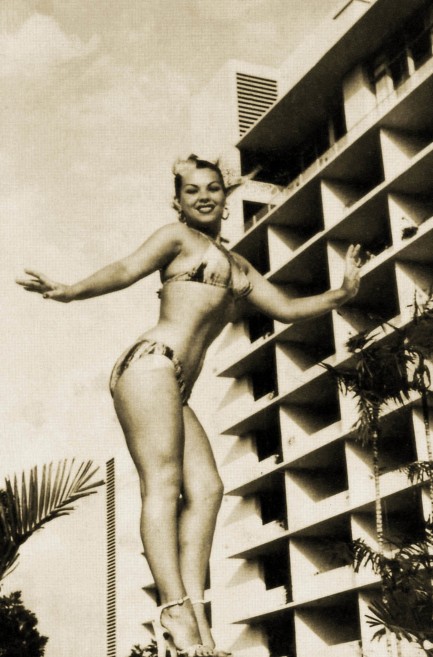 U.S. born vedette and movie star Tongolele, aka Yolanda Montes, poses outside the Capri Hotel and Casino, 1958. U.S. born vedette and movie star Tongolele, aka Yolanda Montes, poses outside the Capri Hotel and Casino, 1958.
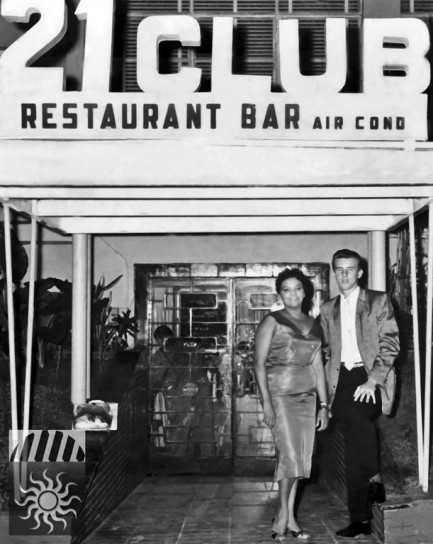 Meme Solis and Elena Burke pose at the entrance to the 21 Club, located in the Capri Hotel. Meme Solis and Elena Burke pose at the entrance to the 21 Club, located in the Capri Hotel.
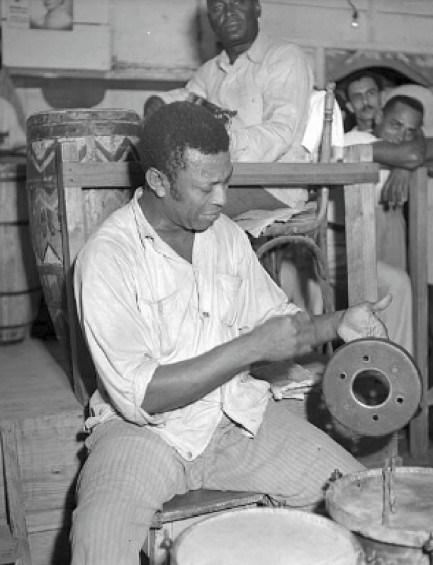 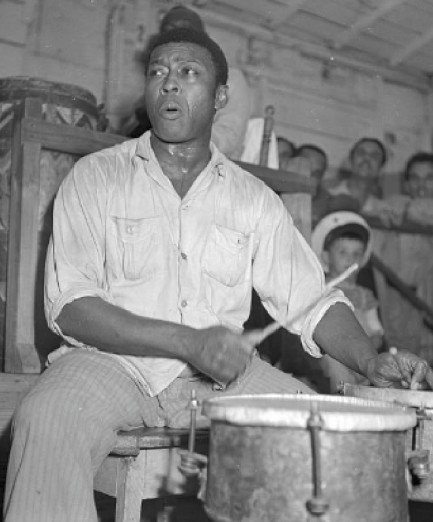 These photos show Silvano Chueg Echevarría, a master of percussion and an iconic musical personage. Let's go back to that Marlon Brando photo for a sec. Brando was an aficionado of percussive instruments. During that 1956 jaunt to Cuba he made it known that he wanted to buy drums from real percussionists. One of the musicians he met was Echevarría. All the Havana percussionists knew of Brando, of course, but thought he was a musical dilettante. At some point he finagled his way onto a nightclub stage, sat in with a band, and truly amazed onlookers with his ability on the conga. He wasn't a master, but he was pretty good. He won respect, and bought his drums. These photos show Silvano Chueg Echevarría, a master of percussion and an iconic musical personage. Let's go back to that Marlon Brando photo for a sec. Brando was an aficionado of percussive instruments. During that 1956 jaunt to Cuba he made it known that he wanted to buy drums from real percussionists. One of the musicians he met was Echevarría. All the Havana percussionists knew of Brando, of course, but thought he was a musical dilettante. At some point he finagled his way onto a nightclub stage, sat in with a band, and truly amazed onlookers with his ability on the conga. He wasn't a master, but he was pretty good. He won respect, and bought his drums.
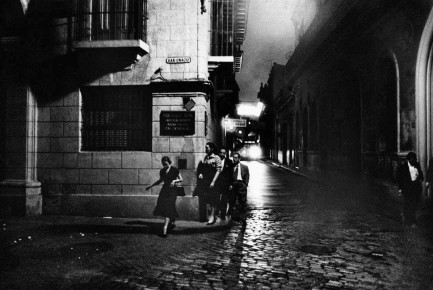 Raquel Revuelta, Manuel Corrales, and Mariano Rodriguez leave the famed bar Bodeguita del Medio and walk through the Havana night to other locales, other adventures, 1958. Raquel Revuelta, Manuel Corrales, and Mariano Rodriguez leave the famed bar Bodeguita del Medio and walk through the Havana night to other locales, other adventures, 1958.

|
 |

The headlines that mattered yesteryear.
1967—First Space Program Casualty Occurs
Soviet cosmonaut Vladimir Komarov dies in Soyuz 1 when, during re-entry into Earth's atmosphere after more than ten successful orbits, the capsule's main parachute fails to deploy properly, and the backup chute becomes entangled in the first. The capsule's descent is slowed, but it still hits the ground at about 90 mph, at which point it bursts into flames. Komarov is the first human to die during a space mission. 1986—Otto Preminger Dies
Austro–Hungarian film director Otto Preminger, who directed such eternal classics as Laura, Anatomy of a Murder, Carmen Jones, The Man with the Golden Arm, and Stalag 17, and for his efforts earned a star on Hollywood's Walk of Fame, dies in New York City, aged 80, from cancer and Alzheimer's disease. 1998—James Earl Ray Dies
The convicted assassin of American civil rights leader Martin Luther King, Jr., petty criminal James Earl Ray, dies in prison of hepatitis aged 70, protesting his innocence as he had for decades. Members of the King family who supported Ray's fight to clear his name believed the U.S. Government had been involved in Dr. King's killing, but with Ray's death such questions became moot. 1912—Pravda Is Founded
The newspaper Pravda, or Truth, known as the voice of the Communist Party of the Soviet Union, begins publication in Saint Petersburg. It is one of the country's leading newspapers until 1991, when it is closed down by decree of then-President Boris Yeltsin. A number of other Pravdas appear afterward, including an internet site and a tabloid. 1983—Hitler's Diaries Found
The German magazine Der Stern claims that Adolf Hitler's diaries had been found in wreckage in East Germany. The magazine had paid 10 million German marks for the sixty small books, plus a volume about Rudolf Hess's flight to the United Kingdom, covering the period from 1932 to 1945. But the diaries are subsequently revealed to be fakes written by Konrad Kujau, a notorious Stuttgart forger. Both he and Stern journalist Gerd Heidemann go to trial in 1985 and are each sentenced to 42 months in prison.
|

|
|

It's easy. We have an uploader that makes it a snap. Use it to submit your art, text, header, and subhead. Your post can be funny, serious, or anything in between, as long as it's vintage pulp. You'll get a byline and experience the fleeting pride of free authorship. We'll edit your post for typos, but the rest is up to you. Click here to give us your best shot.

|
|













































 as a great place to go for thrills. During the 1980s, Ibiza or Mykonos. The 90s, Thailand or Goa. The 00s, Tulum. Havana wasn't unusual in terms of what it offered. Bigger, yes. More convenient for Americans, for sure. But numerous far flung locales have served as paradises for foreign visitors to lose themselves and get crazy.
as a great place to go for thrills. During the 1980s, Ibiza or Mykonos. The 90s, Thailand or Goa. The 00s, Tulum. Havana wasn't unusual in terms of what it offered. Bigger, yes. More convenient for Americans, for sure. But numerous far flung locales have served as paradises for foreign visitors to lose themselves and get crazy. type of expatriate experience. It's unavoidable. A friend of ours lived in a stick shack on Cayos Cochinos for an entire year and he was still considered a rich foreigner. Everyone knows you have a choice. The Americans who partied in Cuba could never have been anything but wealthy invaders, no matter the reality of their finances, or the inclusiveness their sensibilities.
type of expatriate experience. It's unavoidable. A friend of ours lived in a stick shack on Cayos Cochinos for an entire year and he was still considered a rich foreigner. Everyone knows you have a choice. The Americans who partied in Cuba could never have been anything but wealthy invaders, no matter the reality of their finances, or the inclusiveness their sensibilities. look at Havana partying shots we don't quite see oblivious, entitled people, because we know it isn't that simple. Most of them knew what was percolating. Stability was diminishing fast. There was a dissolved parliament, large protests, a 1953 battle in Santiago de Cuba, and other signposts on the way to change. It was clear the fun could never last.
look at Havana partying shots we don't quite see oblivious, entitled people, because we know it isn't that simple. Most of them knew what was percolating. Stability was diminishing fast. There was a dissolved parliament, large protests, a 1953 battle in Santiago de Cuba, and other signposts on the way to change. It was clear the fun could never last. An ice cream vendor patiently waits for potential customers to emerge from the Capri Hotel and Casino, 1958.
An ice cream vendor patiently waits for potential customers to emerge from the Capri Hotel and Casino, 1958. Fashion model Jean Patchett and author Ernest Hemingway, who habitually went shirtless, lounge at Finca Vigia, his house in Cuba, 1950.
Fashion model Jean Patchett and author Ernest Hemingway, who habitually went shirtless, lounge at Finca Vigia, his house in Cuba, 1950. Above, Constantino Ribalaigua Vert, the "Cocktail King of Havana," inventor of the Papa Doble daiquiri, and owner of the famed bar La Floridita.
Above, Constantino Ribalaigua Vert, the "Cocktail King of Havana," inventor of the Papa Doble daiquiri, and owner of the famed bar La Floridita.
 Liberace performs on stage at the Tropicana with headline dancer Ana Gloria Varona, 1954.
Liberace performs on stage at the Tropicana with headline dancer Ana Gloria Varona, 1954. A Coke and a smile from two soft drink vendors.
A Coke and a smile from two soft drink vendors. Patrons enjoy drinks at La Floridita, 1955.
Patrons enjoy drinks at La Floridita, 1955. Cuban writer Guillermo Cabrera Infante stands by while Marlon Brando tries his hand—or both of them—at the conga drum at Hotel Packard, 1956.
Cuban writer Guillermo Cabrera Infante stands by while Marlon Brando tries his hand—or both of them—at the conga drum at Hotel Packard, 1956. Mafia kingpin Meyer Lansky, on the right in this shot, attends the opening of the Hotel Riviera in December 1957.
Mafia kingpin Meyer Lansky, on the right in this shot, attends the opening of the Hotel Riviera in December 1957. Famed entertainer Zulema dances the rhumba at the Zombie Club, 1946.
Famed entertainer Zulema dances the rhumba at the Zombie Club, 1946. Three women liven up the room from their perch on the bar at Cabaret Kursal.
Three women liven up the room from their perch on the bar at Cabaret Kursal. Cesar Romero and Tyrone Power enjoy a drink and a chat at Sloppy Joe's Bar.
Cesar Romero and Tyrone Power enjoy a drink and a chat at Sloppy Joe's Bar. Revelers including Errol Flynn and Desi Arnaz, Jr. form a conga line during the Yoruba festival known as Dia de Babalú-Ayé.
Revelers including Errol Flynn and Desi Arnaz, Jr. form a conga line during the Yoruba festival known as Dia de Babalú-Ayé. José Abeal Otero, founder of Sloppy Joe's Bar, mixes up a giant batch of liquid magic. No, this isn't the same person as above, Ribalaigua. They were both small, dapper guys.
José Abeal Otero, founder of Sloppy Joe's Bar, mixes up a giant batch of liquid magic. No, this isn't the same person as above, Ribalaigua. They were both small, dapper guys. A firebreather thrills onlookers in front of the Saratoga Hotel, 1949.
A firebreather thrills onlookers in front of the Saratoga Hotel, 1949. This photo shows Nat King Cole and his wife Maria Cole, along with Martin Fox, who was the owner of the Tropicana, accompanied by his wife Ofelia and an unknown fifth party.
This photo shows Nat King Cole and his wife Maria Cole, along with Martin Fox, who was the owner of the Tropicana, accompanied by his wife Ofelia and an unknown fifth party. U.S. born vedette and movie star Tongolele, aka Yolanda Montes, poses outside the Capri Hotel and Casino, 1958.
U.S. born vedette and movie star Tongolele, aka Yolanda Montes, poses outside the Capri Hotel and Casino, 1958. Meme Solis and Elena Burke pose at the entrance to the 21 Club, located in the Capri Hotel.
Meme Solis and Elena Burke pose at the entrance to the 21 Club, located in the Capri Hotel.
 These photos show Silvano Chueg Echevarría, a master of percussion and an iconic musical personage. Let's go back to that Marlon Brando photo for a sec. Brando was an aficionado of percussive instruments. During that 1956 jaunt to Cuba he made it known that he wanted to buy drums from real percussionists. One of the musicians he met was Echevarría. All the Havana percussionists knew of Brando, of course, but thought he was a musical dilettante. At some point he finagled his way onto a nightclub stage, sat in with a band, and truly amazed onlookers with his ability on the conga. He wasn't a master, but he was pretty good. He won respect, and bought his drums.
These photos show Silvano Chueg Echevarría, a master of percussion and an iconic musical personage. Let's go back to that Marlon Brando photo for a sec. Brando was an aficionado of percussive instruments. During that 1956 jaunt to Cuba he made it known that he wanted to buy drums from real percussionists. One of the musicians he met was Echevarría. All the Havana percussionists knew of Brando, of course, but thought he was a musical dilettante. At some point he finagled his way onto a nightclub stage, sat in with a band, and truly amazed onlookers with his ability on the conga. He wasn't a master, but he was pretty good. He won respect, and bought his drums. Raquel Revuelta, Manuel Corrales, and Mariano Rodriguez leave the famed bar Bodeguita del Medio and walk through the Havana night to other locales, other adventures, 1958.
Raquel Revuelta, Manuel Corrales, and Mariano Rodriguez leave the famed bar Bodeguita del Medio and walk through the Havana night to other locales, other adventures, 1958.




































































